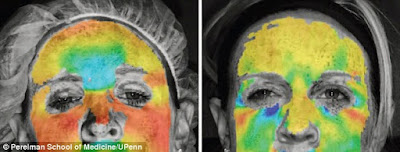Doctors are using a 3D imaging technique commonly used in the car industry to see the impact Botox has on people.
The procedure, called three-dimensional speckle tracking photogrammetry, uses photography to measure distances between black dots.
The dots are then followed by a digital camera, and the change in their position is measured to find out if wrinkles have disappeared or been reduced.
Using the technique, researchers at the University of Pennsylvania were able to create a colour-coded heat map showing the results of Botox.
Red indicates the areas of greatest muscle strain and blue shows areas of lesser strain.
'There is a growing body of evidence that injectable fillers for both cosmetic and reconstructive purposes can have significant psychological benefits,' said senior author Ivona Percec.
'With more people turning to this procedure, it is important to have evidence-based ways of improving cosmetic and reconstructive surgical results.'
Injectable fillers reduce or eliminate wrinkles by relaxing the muscles responsible for their development.
After treatment, the muscles gradually become less active, allowing the overlying skin to appear smoother.
In the new study, the Penn team studied fourteen subjects using a dual camera system and three-dimensional optical analysis.
The 3D imaging technique - more commonly used by mechanical engineers to measure strain on various materials - has recently been applied to measuring the properties of human tissue.
Read more: http://www.dailymail.co.uk/sciencetech/article-3108136/What-Botox-really-looks-like-Scientists-use-3D-imaging-technique-reveal-wrinkle-reduction-injections-transform-faces.html#ixzz3dHfVrBap
Follow us: @MailOnline on Twitter | DailyMail on Facebook

No comments:
Post a Comment